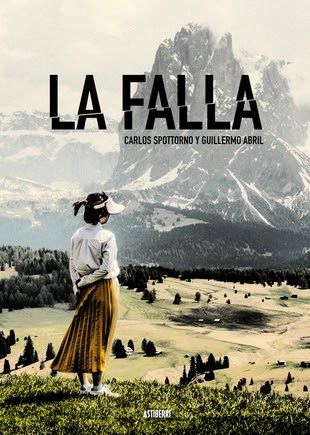
Language: español
Year of publication: 2022
Valuation: between recommendable and okay
Okay, I admit it, my body asked me to start the review with some joke about pardoned dolls, mascletaes or the famous caloret fallerbut since, if I continue like this, any day they are going to kick me off the blog and it is not a question of losing my salary plus expenses and representation expenses, I will contain myself… So, I will comment first of all that The mistake It is the work of the same authors as The crack, interesting graphic essay on the borders of Europe; somewhat peculiar essay, and also in terms of graphics, since the illustrations that appear are not drawings, but conveniently edited photographs, as a “photoessay” (for those who remember the more than vintage fotonovelas). The same method is used in The mistakecreated as a result of an exhibition that its authors were invited to do in Austria, from where they got the idea of preparing a book about the reality of an internal border (today, but not always) of the EU, but that to the Throughout relatively recent history it has been the subject of dispute between states, even with ideologically related regimes: that between Austria and Italy or, if you prefer, between both parts of Tyrol or between North and East Tyrol and Upper Tyrol. Adige, as you prefer… Or, seen another way, between the Latin and Germanic culture and language. A border, furthermore, marked by an orographic element that provides the perfect metaphor for the situation: the fault along which two tectonic plates collided, millions of years ago, giving rise to the Alps.

The authors travel both sides of this border or fault, visiting Austrian and Italian towns and others with a mixed population – also mixed with numerous Asian and African immigrants -, they review the History of this region(s) and stop to look for the vestiges that this past has left in those Alpine lands, from Prehistory to World War I, which had one of its bloody scenarios here and the years of the fascist regime in Italy. but, above all, they examine the current reality of this part(s) of Europe, which oscillates between healing wounds, prosperity – thanks, in large part, to tourism – and the inevitable change that The Old Continent is experiencing in many aspects, perhaps the most obvious being demographic, but also with regard to the dissolution of internal borders. in fact, the book ends (I don’t think it can be considered a spoiler, but I warn you) with a visit to the works of the Brenner tunnel, 64 km. long, which will connect Austria and Italy by rail. Inside, the authors will also be able to contemplate in situ that failure, the real one, which they talk about in the book.
This one turns out, after all, interesting and enjoyable, but perhaps, after The crack, is a little less striking. But, nevertheless, it is advisable to understand how the lines on a map are just that, lines, but they can also determine, in one way or another, the present and future of people (we are seeing it right now in conflicts that, In truth, they are still about dominating certain territories, despite all the ideological and even religious paraphernalia around.
I will limit myself to transcribing some interesting phrases, said by different people who appear in the book, about this peculiar border area, which can be extended to all:
- “The border is a place of communication” (Andreas Putzer, archaeologist)
- “The border is no longer at the border” (Andreas Oberprantacher, philosopher at the University of Innsbruck)
- “Here are the borders of the homeland” (Latin. Italian Victory Arch)
- “No one has the right to obey“(Hannah Arendt’s paradox inscribed on a fascist frieze)
- “Civilizations change, as happened with Greece and Rome. I am probably the last German or Italian mayor. The next one will be Indian” /Thomas Klapfer, mayor of Fortezza)
- “Peace can be boring. And that’s why they engage in speeches and ideas that try to dynamite them.“(the authors of the book)

Source: https://unlibroaldia.blogspot.com/2023/12/carlos-spottorno-y-guillermo-abril-la.html


